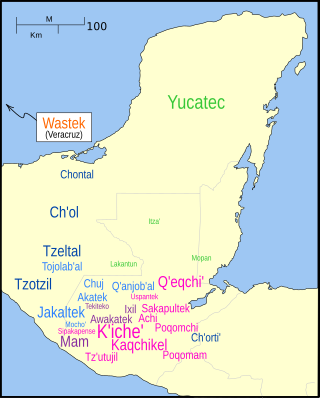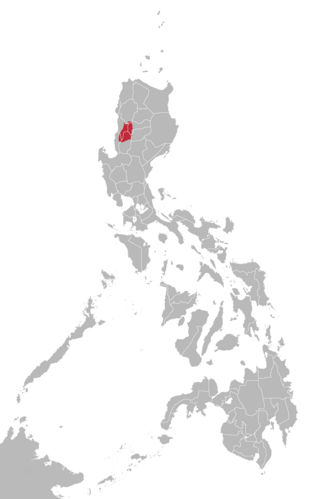In linguistics, an affix is a morpheme that is attached to a word stem to form a new word or word form. The main two categories are derivational and inflectional affixes. The first ones, such as -un, -ation, anti-, pre- etc, introduce a semantic change to the word they are attached to. The latter ones introduce a syntactic change, such as singular into plural, or present simple tense into present continuous or past tense by adding -ing, -ed to a word. All of them are bound morphemes by definition; prefixes and suffixes may be separable affixes.
Morphological derivation, in linguistics, is the process of forming a new word from an existing word, often by adding a prefix or suffix, such as un- or -ness. For example, unhappy and happiness derive from the root word happy.
A root is the core of a word that is irreducible into more meaningful elements. In morphology, a root is a morphologically simple unit which can be left bare or to which a prefix or a suffix can attach. The root word is the primary lexical unit of a word, and of a word family, which carries aspects of semantic content and cannot be reduced into smaller constituents. Content words in nearly all languages contain, and may consist only of, root morphemes. However, sometimes the term "root" is also used to describe the word without its inflectional endings, but with its lexical endings in place. For example, chatters has the inflectional root or lemma chatter, but the lexical root chat. Inflectional roots are often called stems, and a root in the stricter sense, a root morpheme, may be thought of as a monomorphemic stem.
In its strictest sense, tmesis is a word compound that is divided into two parts, with another word infixed between the parts, thus constituting a separate word compound. Example: "un-freaking-believable". In a broader sense, tmesis is a recognizable phrase or word that is divided into two parts, with one or more words interpolated between the parts, thus creating a separate phrase.
Expletive infixation is a process by which an expletive or profanity is inserted into a word, usually for intensification. It is similar to tmesis, but not all instances are covered by the usual definition of tmesis because the words are not necessarily compounds.

Tzeltal or Tseltal is a Mayan language spoken in the Mexican state of Chiapas, mostly in the municipalities of Ocosingo, Altamirano, Huixtán, Tenejapa, Yajalón, Chanal, Sitalá, Amatenango del Valle, Socoltenango, Las Rosas, Chilón, San Juan Cancuc, San Cristóbal de las Casas and Oxchuc. Tzeltal is one of many Mayan languages spoken near this eastern region of Chiapas, including Tzotzil, Chʼol, and Tojolabʼal, among others. There is also a small Tzeltal diaspora in other parts of Mexico and the United States, primarily as a result of unfavorable economic conditions in Chiapas.
In linguistics, a word stem is a part of a word responsible for its lexical meaning. Typically, a stem remains unmodified during inflection with few exceptions due to apophony
Wiyot or Soulatluk (lit. 'your jaw') is an Algic language spoken by the Wiyot people of Humboldt Bay, California. The language's last native speaker, Della Prince, died in 1962.

Kankanaey is a South-Central Cordilleran language under the Austronesian family spoken on the island of Luzon in the Philippines primarily by the Kankanaey people. Alternate names for the language include Central Kankanaey, Kankanai, and Kankanay. It is widely used by Cordillerans, alongside Ilocano, specifically people from Mountain Province and people from the northern part of the Benguet Province. Kankanaey has a slight mutual intelligibility with the Ilocano language.
Proto-Indo-European verbs reflect a complex system of morphology, more complicated than the substantive, with verbs categorized according to their aspect, using multiple grammatical moods and voices, and being conjugated according to person, number and tense. In addition to finite forms thus formed, non-finite forms such as participles are also extensively used.

Quechan or Kwtsaan, also known as Yuma, is the native language of the Quechan people of southeastern California and southwestern Arizona in the Lower Colorado River Valley and Sonoran Desert. Despite its name, it is not related to the Quechua language of the Andes.
In linguistic morphology, a transfix is a discontinuous affix which is inserted into a word root, as in root-and-pattern systems of morphology, like those of many Semitic languages.
Tsimshian, known by its speakers as Sm'álgyax, is a dialect of the Tsimshian language spoken in northwestern British Columbia and southeastern Alaska. Sm'algyax means literally "real or true language."
Sesotho verbs are words in the language that signify the action or state of a substantive, and are brought into agreement with it using the subjectival concord. This definition excludes imperatives and infinitives, which are respectively interjectives and class 14 nouns.
This article presents a brief overview of the grammar of the Sesotho and provides links to more detailed articles.

In linguistic morphology, inflection is a process of word formation in which a word is modified to express different grammatical categories such as tense, case, voice, aspect, person, number, gender, mood, animacy, and definiteness. The inflection of verbs is called conjugation, and one can refer to the inflection of nouns, adjectives, adverbs, pronouns, determiners, participles, prepositions and postpositions, numerals, articles, etc., as declension.
The nasal infix is a reconstructed nasal consonant or syllable *⟨n(é)⟩ that was inserted (infixed) into the stem or root of a word in the Proto-Indo-European language. It has reflexes in several ancient and modern Indo-European languages. It is one of the affixes that mark the present tense.
An expletive attributive is an adjective or adverb that does not contribute to the meaning of a sentence, but is used to intensify its emotional force. Often such words or phrases are regarded as profanity or "bad language", though there are also inoffensive expletive attributives. The word is derived from the Latin verb explere, meaning "to fill", and it was originally introduced into English in the 17th century for various kinds of padding.
The grammar of the constructed Na'vi language was created for the movie Avatar by Paul Frommer. It is a tripartite, primarily affixing agglutinative language.
This article describes the grammar of the Old Irish language. The grammar of the language has been described with exhaustive detail by various authors, including Thurneysen, Binchy and Bergin, McCone, O'Connell, Stifter, among many others.



